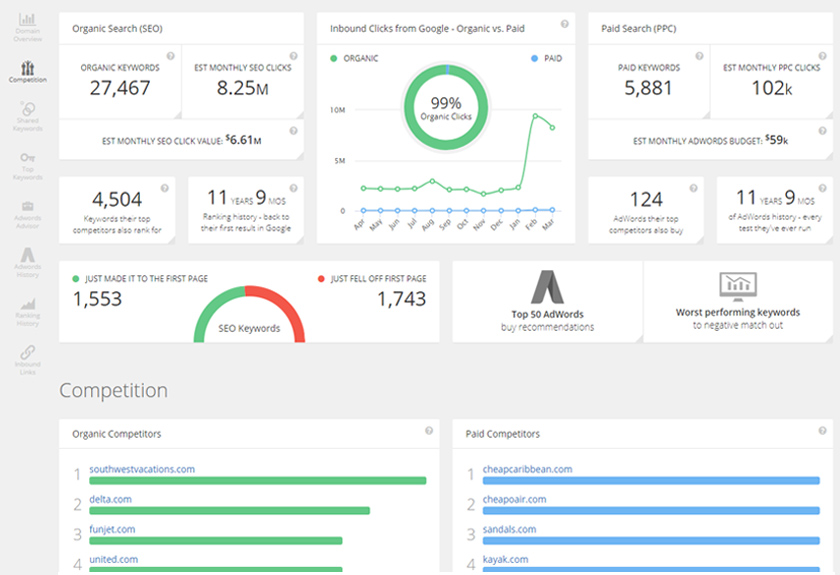It goes without saying that your business growth partially relies on your ability to dominate your competition and claim the top seat in your industry’s online space.
In order to conquer your industry by being that go-to business, there are a number of things you must set out to achieve that range from better understanding your customers and providing them with the right content, to digging down at the strategic level with the help of a digital marketing agency that offers custom growth stacks for every client.
Online competitor research is one of many tasks that will help businesses fine-tune their digital marketing strategies. Ideally, this should be performed in the early stage of onboarding.
Whether you are about to take that first step to creating your digital footprint, or you’ve been up and running and just now starting to analyze your competition’s online presence, these five tips will help you get solid insight into what your competitors are doing to improve their visibility and growth, and provide you with options to do something even better.
1. Identify Your SEO Competitors
An SEO competitor is someone who organically ranks for the primary search phrases that pertain to your business.
In many cases a company’s actual competitors and their SEO competitors don’t line up and even cross industries. For example, let’s say there is a fencing school that wants to rank and attract more students to learn the art of sword play.
When they do a Google search for “fencing in Los Angeles”, every single result on page one of the search results is for companies that build fences for property owners. Although these two industries are night and day from one another, the fence-building sites are SEO competitors for the fencing school.
Compile a list of the main search phrases that pertain to your business, products and services. Then see who ranks for these terms. If a search result ranks for multiple search phrases then consider this your main competitor.
Additionally you can enter keywords and see who ranks, but keep in mind that buyer behavior has changed dramatically. This means most people use organic, natural language when searching for products and services.
2. Use Competitor Research Tools
There are a number of tools you can use to gain valuable insight into your competition. These tools analyze your competition’s site, compare their standing to yours, and some even provide data pertaining to paid search and social signals.
SEMrush is an ideal tool to use for researching your competitor’s organic ranking history and keywords and search terms they rank for. SEMrush allows a number of free searches before you need to sign up for their trial.
SpyFu is another tool that provides more comprehensive competitor data ranging from how much they spend on average in paid search to how many organic clicks they get and for what terms. As you can see in this SpyFu screenshot capturing the airline Jet Blue’s data, the report is broken down into buckets for organic and paid, while showing their top competitors with access to the same data.
Monthly Domanin Overview – Jet Blue
3. Check their Backlinks
Once you have defined your top SEO competitors you will want to check their backlink portfolio. Backlinks are valuable because, if the links are healthy, they help improve a site’s domain authority. However, if the links are poor quality the search engines can deem them as spam and you can drop in ranking or in some cases even get hit with a Google penalty.
A healthy backlink should:
• Come from a site with a high domain authority
• Demonstrate trust
• Have content relevant to the content on its landing page
• Has a follow tag as opposed to nofollow
You can use tools like Open Site Explorer to check your competitor’s backlinks. Make a list of the strong ones, what domains these are, and then do a bit of research to see what their guidelines are for guest posts.
You will want to target the same domains for backlinks while looking for similar domains, and any referring domain with a healthy presence that is relative to your industry.
4. Analyze their Blog
Blogging is still a crucial component to any digital marketing strategy. In a 2017 article by Search Engine Journal the author says that “blogging is critical” for business, and “bland, run-of-the-mill blog posts won’t cut it”. The article goes on to say that such content is ineffective and lazy.
First, determine if your competitor’s blog is uninspiring vanilla stuffed with keywords, or if it focuses on hot industry topics that strive to resolve consumer needs. With recent improvements in mobile voice search and the increase in smart home searches, content created to address common concerns in natural language not only ranks well, but converts well too.
Remember that blogs serve more purposes than improving SEO. Good content will nurture and convert customers, continue to engage existing buyers, create brand awareness and differentiate you from similar businesses.
Find out what your competitors do well in their blogging strategy, and look for opportunities in their shortcomings. Be the expert voice in your industry and in time your visibility and online reputation will likely align.
5. Identify Your Social Media Competitors
Understanding who your social media competitors are is paramount to hitting your growth goals through a well-thought out digital marketing strategy. Having an active presence in social media is valuable because it:
• Generates valuable social signals to your website to improve SEO
• Allows for easy access to targeted audiences
• Provides opportunities for people to “market for you” by sharing your content
• Gives you the ability to promote your brand’s identity and voice
• Offers entry points into inbound workflows
• Draws traffic to your blog and product pages
There are a number of growth hacking strategies that can be performed using various social media platforms. These can range from complex strategies that involve multiple personas engaging through automated software, to conversational strategies within groups.
When beginning to discover how your competitors appear in Facebook, Twitter and Instagram, consider using social mentioning tools like Hootsuite. This platform not only allows you to see how often your competition posts content and how they engage with their customers but it also allows you to manage your own social media presence.
When analyzing your competition’s social media presence pay attention to the type of messages and articles that people like, and don’t like. You should also pinpoint the times of day when people engage the most with your competitors, and when buyers are less active.
Plan your content, target audience, and posting schedule based around what works best for your competition. Then analyze your own internal after a few months of incurred data collection, and make any necessary adjustments to streamline your engagement strategy.
Competitor Analysis Leads to Big Win Opportunities
Executing a comprehensive competitor analysis mission will give you data and insight into improving multiple facets of your digital marketing strategy.
From making improvements to your SEO efforts to engaging with your buyers, identifying the strengths and weaknesses within your industry’s players will help you position yourself to business dominance within your digital space.
Array



